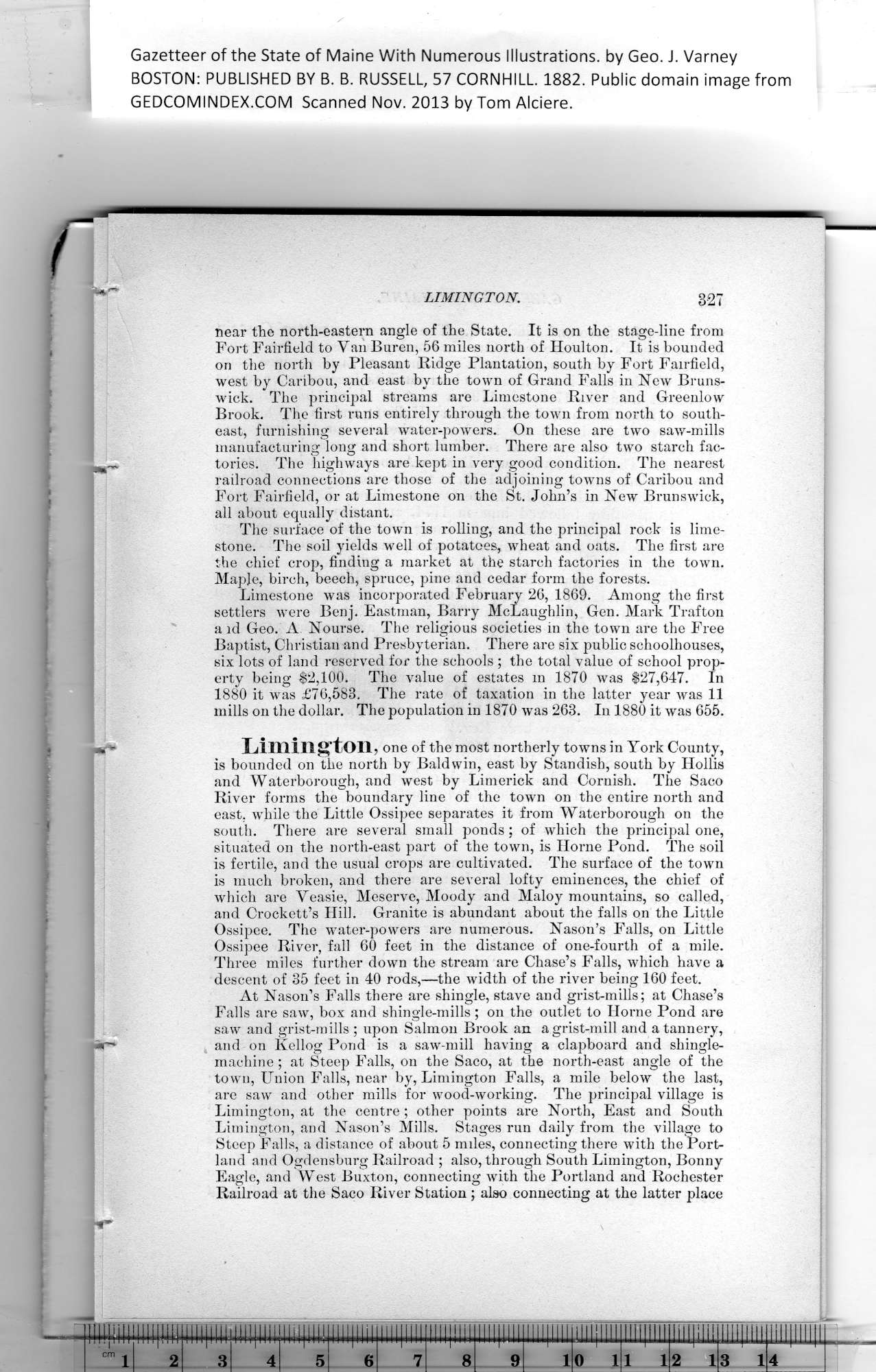|
Gazetteer of the State of Maine With Numerous Illustrations, by Geo. J. Varney
BOSTON: PUBLISHED BY B. B. RUSSELL, 57 CORNHILL. 1882. Public domain image from
LIMINGTON. 3-27
near the north-eastern angle of the State. It is on the stage-line from
Fort Fairfield to Van Buren, 56 miles north of Houlton. It is bounded
on the north by Pleasant Ridge Plantation, south by Fort Fairfield,
west by Caribou, and east by the town of Grand Falls in New Bruns-
wick. The principal streams are Limestone River and Greenlow
Brook. The first runs entirely through the town from north to south-
east, furnishing several water-powers. On these are two saw-mills
manufacturing long and short lumber. There are also two starch fac-
tories. The highways are kept in very good condition. The nearest
railroad connections are those of the adjoining towns of Caribou and
Fort Fairfield, or at Limestone on the St. John’s in New Brunswick,
all about equally distant.
The surface of the town is rolling, and the principal rock is lime-
stone. The soil yields well of potatoes, wheat and oats. The first are
the chief crop, finding a market at the starch factories in the town.
Maple, birch, beech, spruce, pine and cedar form the forests.
Limestone was incorporated February 26, 1869. Among the first
settlers were Benj. Eastman, Barry McLaughlin, Gen. Mark Trafton
a id Geo. A. Nourse. The religious societies in the town are the Free
Baptist, Christian and Presbyterian. There are six public schoolhouses,
six lots of land reserved for the schools ; the total value of school prop-
erty being $2,100. The value of estates m 1870 was $27,647. In
1880 it wrns £76,583. The rate of taxation in the latter year was 11
mills on the dollar. The population in 1870 was 263. In 1880 it was 655.
Liminglon, one of the most northerly towns in York County,
is bounded on the north by Baldwin, east by Standish, south by Hollis
and Waterborough, and west by Limerick and Cornish. The Saco
River forms the boundary line of the town on the entire north and
east, while the Little Ossipee separates it from Waterborough on the
south. There are several small ponds; of which the principal one,
situated on the north-east part of the town, is Horne Pond. The soil
is fertile, and the usual crops are cultivated. The surface of the town
is much broken, and there are several lofty eminences, the chief of
which are Veasie, Meserve, Moody and Maloy mountains, so called,
and Crockett’s Hill. Granite is abundant about the falls on the Little
Ossipee. The water-powers are numerous. Nason’s Falls, on Little
Ossipee River, fall 60 feet in the distance of one-fourth of a mile.
Three miles further down the stream are Chase’s Falls, which have a
descent of 35 feet in 40 rods,—the width of the river being 160 feet.
At Nason’s Falls there are shingle, stave and grist-mills; at Chase’s
Falls are saw, box and shingle-mills ; on the outlet to Horne Pond are
saw and grist-mills ; upon Salmon Brook an a grist-mill and a tannery,
and on Kellog Pond is a saw-mill having a clapboard and shingle-
machine ; at Steep Falls, on the Saco, at the north-east angle of the
town, Union Falls, near by, Limington Falls, a mile below the last,
are saw and other mills for wood-working. The principal village is
Limington, at the centre ; other points are North, East and South
Limington, and Nason’s Mills. Stages run daily from the village to
Steep Falls, a distance of about 5 miles, connecting there with the Port-
land and Ogdensburg Railroad ; also, through South Limington, Bonny
Eagle, and West Buxton, connecting with the Portland and Rochester
Railroad at the Saco River Station ; also connecting at the latter place
PREVIOUS PAGE ... NEXT PAGE
This page was written in HTML using a program written in Python 3.2
|
